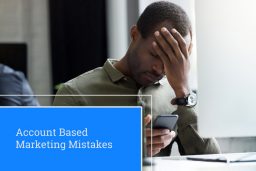
Today, ABS might be a buzzword in B2B sales domain but sales specialists say that it has always been used, without attaching a “name” to the process. In modern sales structure B2B experts have coined a term for this sales process of targeting individual accounts. Through this post we explore various aspects of Account Based Selling (ABS) model in depth.
What is account based selling?
Account Based Selling (ABS) is applied in B2B selling space where the sales team’s approach is to identify and go after big businesses. In case of ABS the targeted business is treated as an individual account.
ABS, as defined by Kyle Porter of Salesloft, is an “all encompassing approach of going after the list of targeted accounts that fit your ideal customer profile.”
In a well organized ABS model the sales and marketing teams have the same goal of getting the big pre-qualified account into the funnel. This results in closely aligned sales and marketing departments.
How has the sales funnel changed with ABS?
ABS has made top of the sales funnel narrower. In traditional sales cycle there were various stages of generating leads, qualifying them, converting and nurturing them post sales. However, because of ABS, which is much more proactive in identifying the key persons attached to the targeted account, sales funnel gets a makeover.
Also, since marketing is aligned to sales in this case, the marketing collaterals are personalized after thorough research on stakeholders like why would they need your solution. Whereas, in traditional sales funnel marketing can be disjoint with sales and comes earlier in the initial broader stage of funnel where the business is trying to generate leads with some marketing campaign.
To sum up, account based sales funnel is inverted.
At the top are the identified and qualified accounts. Next stage is finding the top decision makers in those accounts. This is where marketing comes into funnel, as with right kind of personalized content drafted by marketing department your sales need to engage with the top level executives. This can’t be mass mailer campaign for all the accounts. It is curtailed around the perceived requirements of the accounts. Last is nurturing the leads before and after they convert to build a better and lasting relationship with the influencers in an account.
How did ABS change sales team structure?
With ABS in frame, the sales team gets divided into smaller teams. Each handles one or more accounts and gets involved at various levels of sales funnel.
However, irrespective of their roles, these individuals in micro teams work towards the same goal of bringing an account onboard.
Hence, the individuals in account based sales team structure are focused and better aligned where each one clearly knows what they are expected to do.
- SDRs or Sales Development Reps start much earlier in the process by identifying the prospect businesses. There can be more than one SDR in each team. All of them need to qualify the leads proactively by making cold calls, sending emails and finally identifying the best fit.
- Account Executives get the identified lead from the SDR. Their primary job is to close the leads by running multiple personalized engaging marketing campaigns. They get appointments from prospects to demo the product/ services, final sign off from the customer. All of these are done while nurturing the account throughout the process i.e., before the sign off.
- Account Managers or Customer Success Managers come after the deal is closed to maintain the relationship with influencers of the particular business. They nurture the account so that all the requirements and needs of the clients get fulfilled post-sales. Apart from that, if they find any upsell and cross-sell opportunity in the current account they ask the SDRs to get in touch with the decision makers again.
Overall, it’s a team work and all get compensated if the deal is won! There’s better alignment within the structure and ownership doesn’t lie with one team member.
Difference between traditional sales and ABS
The major difference is who the sales team consider as buyer. In traditional sales they identify an individual in the account and can pursue them forever. Whereas in ABS they identify businesses in a particular domain having similar type of problems and sell to the influencers and decision makers of those targeted businesses.
ABS has these important steps:
- Identify the business or account that might be seriously interested in your business.
- Identify the decision makers in the targeted business and develop their personas.
- Identify the mediums to get in touch with these individuals.
In step #3, marketing team also comes into picture, where for every level of engagement and every touch point they draft and design various marketing materials. It becomes extremely important to involve other persons outside your sales department to do the talking with the other party individuals, if need be. For instance, your CTO getting in touch with CTO of your target, VP of Marketing communicating with VP of Marketing in targeted account. What this means is that at every instance there are experts in and outside the team to handle prospect’s questions and problems.
Benefits of ABS and how it improves sales team’s efficiency
ABS in a mature organization has the following numerous advantages:
Sales team gets divided based on what they are good at. If someone is good at making the first contact and convincing for the demo then it’s best to let the person focus on what they know best. Hence, this results in super specialized and focused team structure where individuals concentrate on the completion of assigned task.
It won’t be wrong to say that ABS works on the principle of assembly line process!
- Technology has added tremendously to the success of ABS. Businesses on the selling side do make use of data for sales insight to know about their hottest lead/ account in the pipeline. The ubiquitous influence of data is felt on the sales and marketing too. Sales insight is used constantly to update various touch point and marketing content, which makes the process efficient.
- Aligned sales and marketing teams work to provide engaging content and campaign.
- Due diligence leads to better and personalized content which is much more effective and doesn’t sound pushy and spammy!
How customers handle ABS
ABS is about smart and efficient way of selling where multiple people with varied roles get in touch with one or more decision makers on the buyer’s side. Does that lead to confusion and chaos on the buyer’s side? How do both the parties handle it?
From customer’s perspective ABS is yet another sales strategy if the seller’s team is efficient and experienced in graceful handovers and takeovers. So, within the seller’s team information about prospect should be passed on smoothly from one member to next who is going to handle that account. The same needs to be communicated coherently to the targeted account’s individuals to avoid confusion.
ABS model is definitely highly challenging, efficient and effective but it is not for everyone. In case of high transactional sales it is best to stick to traditional approach because ABS can be time consuming multiple iterations with stakeholders and multiple buy ins. However, if you have a steady flow of subscribers for your product and services, it’s time to move to ABS model and reap its benefits.
For more information about MoData offerings click here




